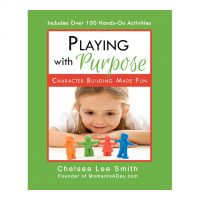There was once a little boy who didn’t do as he was told. He told lies, went places he wasn’t supposed to go, and did things that he was specifically told not to do.
Sound familiar?
I bet it does! All children test the rules and the boundaries they are given.
But I’m not talking about just anyone. I’m talking about Pinnochio! Did you hear that story as a child? Think back about what parts you remember and any lessons you may have learned from it.

The story (or movie) of Pinnochio is a classic example of disobedience. It is meant to show what happens when kids don’t obey and serve as a warning for them to heed the rules of their family/society.
Much more effective than rehashing what happened in the playground yesterday in a long lecture to your six-year-old, right?
How to teach obedience to young children
Reading and discussing stories like Pinnochio, Little Red Riding Hood, or A Fish Out of Water (affiliate link) are great ways to introduce the concept of obedience to young children. They are tangible, memorable, and a lot more fun than a speech from a parent.
Another way to introduce the virtue of obedience to kids is through games like “Simon Says” and “Mother May I”. These games help kids understand what it means to follow the rules and give them an interactive way to explore this character trait.
Slightly older kids may enjoy sports like martial arts or soccer which build discipline around listening to your coach.
Discussing road rules and following a recipe together show the reason why it’s important to obey. If we don’t follow directions, we may get into an accident or our cake may not turn out well! When kids understand the role of obedience in their lives and in the organisation of the community, they can see the reasoning behind it all.
Practicing obedience and seeing it played out in numerous situations sets the foundation for understanding the importance of this virtue.
Above all…
Teaching kids to listen and do as they are told is secondary to having a strong relationship with a child. When children love and trust the adults in their lives, they are more likely to follow their lead. That doesn’t mean they won’t test the boundaries though. Experiences help them learn.
Of course we also don’t want our kids to lose their sense of direction and simply do whatever they are asked by anyone in any situation (check out this book for a prime example). Helping our children to follow their inner compass and learn to obey the dictates of their hearts is a life-long gift as well.
Here are some other ideas from other mothers about how to teach obedience to young children:
“We start with our beliefs. I teach my children that I live to a set of guidelines as best as I can (and am always teaching them life lessons from these beliefs) and it is my job to teach them to do the same. We do talk a lot about the fact that everybody fails at times but that what matters is that we refocus on our beliefs and try to do better next time.” – Jaimi from The Stay-at-Home-Mom Survival Guide
“We talk about obedience in relationship to consequences, positive and negative, always in relation to the natural consequences. The easiest one is when talking about putting on seatbelts or carseat straps (which is always a fight with my youngest). Being obedient to the law of putting on your seatbelt protects you and others around you. Talking to them in this way takes the power struggle out of many things because it isn’t an us vs them on things that may seem arbitrarily decided. So, as moral issues become of a more mature nature and being obedient to a law or guideline seems harder to follow, hopefully, the trust and relationship will be there to have honest conversations instead of power struggles of wills.” – Sheila from Pennies of Time: Teaching Kids to Serve
“This is a really tough one. Obedience is based on so many fundamental virtues: love, respect, consideration, kindness, helpfulness and more! We teach our child that ‘Obedience is a sign of Love’ and we talk about what it means, how we can work on being obedient to mommy, daddy, teachers and family members. It is also important to teach a child to make a better judgement, as in no ‘blind’ obedience to whatever adults tell him/her. This process starts from birth and continues for many many years to come and with every step we learn something new together with our child.” – Varya from Little Artists
“This is definitely a work in progress! For us it operates on several levels: We try to explain why we are asking our son to do something, so he understands the logic behind what he is being asked to do, plus he can start to understand that we don’t just arbitrarily make demands – there are reasons behind them, and we do it because we are looking out for his best interests. At the same time, there are times when he has to obey ‘just because’ – particularly when safety is involved. So when we are out in public the rules tend to be stricter because the consequences are greater.” – Leanna from All Done Monkey
How do you teach your kids obedience?
Here are a few more articles that explore teaching this important character trait:
Tips for Parents to Connect versus Correct
Why don’t my kids just do what I say the first time I say it? from Aha Parenting
10 Empowering Ways to Improve Toddler Listening from Military Wife and Mom
What other thoughts or resources do you have about how to teach obedience to young children?
To browse more character building activities on my website, click here. You may also enjoy my ebook with 100+ activities in an easy-to-use checklist format, Playing with Purpose: Character Building Made Fun.



Leave a Reply